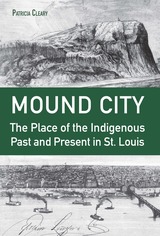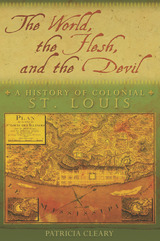2 books about Cleary, Patricia

Mound City
The Place of the Indigenous Past and Present in St. Louis
Patricia Cleary
University of Missouri Press, 2024
Nearly one thousand years ago, Native peoples built a satellite suburb of America's great metropolis on the site that later became St. Louis. At its height, as many as 30,000 people lived in and around present-day Cahokia, Illinois. While the mounds around Cahokia survive today (as part of a state historic site and UNESCO world heritage site), the monumental earthworks that stood on the western shore of the Mississippi were razed in the 1800s. But before and after they fell, the mounds held an important place in St. Louis history, earning it the nickname “Mound City.” For decades, the city had an Indigenous reputation. Tourists came to marvel at the mounds and to see tribal delegations in town for trade and diplomacy. As the city grew, St. Louisans repurposed the mounds—for a reservoir, a restaurant, and railroad landfill—in the process destroying cultural artifacts and sacred burial sites. Despite evidence to the contrary, some white Americans declared the mounds natural features, not built ones, and cheered their leveling. Others espoused far-fetched theories about a lost race of Mound Builders killed by the ancestors of contemporary tribes. Ignoring Indigenous people's connections to the mounds, white Americans positioned themselves as the legitimate inheritors of the land and asserted that modern Native peoples were destined to vanish. Such views underpinned coerced treaties and forced removals, and—when Indigenous peoples resisted—military action. The idea of the “Vanishing Indian” also fueled the erasure of Indigenous peoples’ histories, a practice that continued in the 1900s in civic celebrations that featured white St. Louisans “playing Indian” and heritage groups claiming the mounds as part of their own history. Yet Native peoples endured and in recent years, have successfully begun to reclaim the sole monumental mound remaining within city limits.
Drawing on a wide range of sources, Patricia Cleary explores the layers of St. Louis’s Indigenous history. Along with the first in-depth overview of the life, death, and afterlife of the mounds, Mound City offers a gripping account of how Indigenous histories have shaped the city’s growth, landscape, and civic culture.
Drawing on a wide range of sources, Patricia Cleary explores the layers of St. Louis’s Indigenous history. Along with the first in-depth overview of the life, death, and afterlife of the mounds, Mound City offers a gripping account of how Indigenous histories have shaped the city’s growth, landscape, and civic culture.
[more]

The World, the Flesh, and the Devil
A History of Colonial St. Louis
Patricia Cleary
University of Missouri Press, 2018
As Anglo-American colonists along the Atlantic seaboard began to protest British rule in the 1760s, a new settlement was emerging many miles west. St. Louis, founded simply as a French trading post, was expanding into a diverse global village. Few communities in eighteenth-century North America had such a varied population: indigenous Americans, French traders and farmers, African and Indian slaves, British officials, and immigrant explorers interacted there under the weak guidance of the Spanish governors. As the city’s significance as a hub of commerce grew, its populace became increasingly unpredictable, feuding over matters large and small and succumbing too often to the temptations of “the world, the flesh, and the devil.” But British leaders and American Revolutionaries still sought to acquire the area, linking St. Louis to the era’s international political and economic developments and placing this young community at the crossroads of empire.
With its colonial period too often glossed over in histories of both early America and the city itself, St. Louis merits a new treatment. The first modern book devoted exclusively to the history of colonial St. Louis, The World, the Flesh, and the Devil illuminates how its people loved, fought, worshipped, and traded. Covering the years from the settlement’s 1764 founding to its 1804 absorption into the young United States, this study reflects on the experiences of the village’s many inhabitants.
The World, the Flesh, and the Devil recounts important, neglected episodes in the early history of St. Louis in a narrative drawn from original documentary records. Chapters detail the official censure of the illicit union at the heart of St. Louis’s founding family, the 1780 battle that nearly destroyed the village, Spanish efforts to manage commercial relations between Indian peoples and French traders, and the ways colonial St. Louisans tested authority and thwarted traditional norms. Patricia Cleary argues that St. Louis residents possessed a remarkable willingness to adapt and innovate, which enabled them to survive the many challenges they faced.
The interior regions of the U.S. have been largely relegated to the margins of colonial American history, even though their early times were just as dynamic and significant as those that occurred back east. The World, the Flesh, and the Devil is an inclusive, wide-ranging, and overdue account of the Gateway city’s earliest years, and this engaging book contributes to a comprehensive national history by revealing the untold stories of Upper Louisiana’s capital.
[more]
READERS
Browse our collection.
PUBLISHERS
See BiblioVault's publisher services.
STUDENT SERVICES
Files for college accessibility offices.
UChicago Accessibility Resources
home | accessibility | search | about | contact us
BiblioVault ® 2001 - 2024
The University of Chicago Press









